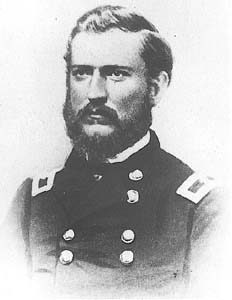
Major General Godfrey Weizel of the The United States Army was the engineer who drew the fortifications at Fort Pocahontas.
Major General Godfrey Weitzel
United States Army
The expression ” Like Grant took Richmond ” has become a part of our language. However, General Grant was never in Richmond in any military capacity. Richmond was, in fact, taken by 30-year-old West Point graduate Major General Godfrey Weitzel.
Born November 1, 1835 in Cincinnati, Ohio. He was appointed to the United States Military Academy in 1851. During his time at West Point, the Superintendent of the Academy was Colonel Robert E. Lee. Cadet Weitzel spent hours of his free time at the home of the Superintendent in the company of Colonel Lee and his family, including Cadet Fitzhugh Lee. This began friendships that would be sorely tested in the years ahead.
Graduating in 1855 standing second in his class of 34, he was commissioned 2nd Lieutenant of Engineers. From 1855 to 1860, he served on the construction and repair of fortifications on the lower Mississippi, was Chief Engineer on the fortifications at Cincinnati, and taught Civil and Military Engineering at West Point. In January 1860, he was assigned as 1st Lieutenant to Company A of the Engineers and sent to Washington DC where Company A became the bodyguard for President Abraham Lincoln at his inauguration
When war began, he went with Company A to Fort Pickens, Florida. Ordered to Washington in December 1861, he was placed in command of Company C of the Engineers in the Army of the Potomac. Ordered to the staff of Major General Ben Butler as Chief Engineer for the New Orleans expedition, his knowledge of Forts Jackson and St. Philip enabled the Fleet to successfully pass those forts, and take the city of New Orleans. He became Assistant Military Commander and Acting Mayor of New Orleans. Promoted to Brigadier General August 29, 1862, he led his Brigade at Bayou LaFouche, Bayou Teche, Sabine Pass, and commanded the right wing at Port Hudson. Ordered east with General Butler, he joined the Army of the James in 1864 for the Bermuda Hundred Campaign. He commanded 2nd Division 18th Corps and served as Chief Engineer for the Army of the James, and was promoted to Major General August 26, 1864. During the heavy fighting on the evening of September 29, 1864, he assumed command of the 18th Corps after General Ord was wounded in action. On September 30, 1864, his Corps, barely 5,000 men, successfully held Fort Harrison on the Richmond defenses (which had been taken from Confederate forces the day before) against counter attacks by two divisions personally commanded by his old Superintendent, General Robert E. Lee.
During the next six months, except for a short time participating in an unsuccessful move against Fort Fisher N.C., he operated on the north side of the James River. Taking command of the new 25th Corps (the first Army corps made up entirely of black troops) in December of 1864, he conducted various probing actions against the Richmond defenses in the New Market and Darbytown Road areas.
On the evening of April 2, 1865, bright light was noticed in the sky over Richmond. General Weitzel ordered patrols out to bring in Confederate pickets for questioning. When two Confederate soldiers were brought in they barely spoke English. They did not know where their unit was and did not know why they had not been relieved. After speaking with them, General Weitzel described them as being Alsatian as “they spoke poor German and worse French.”.
By morning, smoke could be seen rising over the city and explosions could be heard. Weitzel ordered the 24th and 25th Corps into motion. Weitzel himself entered the city just behind a cavalry vanguard of about 40 troopers. He found a city dying in it’s own fires. Citizens crowded the grounds of the capitol to escape the flames, saving only what they could carry. His first order was to General Ripley to put his brigade to fighting the fires and save the city. Hearing that Mrs. Lee was in her home on Franklin Street, General Weitzel dispatched a guard to her residence to protect her from being disturbed. Also ordering a guard placed on the Masonic Temple, the oldest in the country. Weitzel rode to the City Hall, entered and took official possession of the city. Sending a telegram to General Grant that electrified the nation, “We took Richmond at a quarter past eight this morning…”.
Setting up his quarters in the Confederate Whitehouse, he met the next day with President Lincoln. During their discussions, he asked the President what should be done with the people of Richmond. Mr. Lincoln’s answer was, “If I were in your position, General, I think I would let them up easy, let them up easy.”
General Weitzel opened the stores of the Army of the James to the people of Richmond, dispensing food, blankets, clothing, and medicines. The streets were patrolled and property protected from looters.
Hearing, some days later, that his old friend General Fitzhugh Lee was staying at the Lee home in Richmond, General Weitzel sent an aide to the Lee residence carrying Weitzel’s purse and offering to Fitzhugh any sum that might be needed to secure the safety and comfort of the Lee family.
(General Robert E. Lee and his wife were also staying there.) Fitzhugh expressed his thanks, but all that they might need would be an authorization for the daughters of General Robert Lee to join them in Richmond. General Weitzel immediately provided the passes needed to accomplish this.
An order came from the War Department in Washington that a prayer for President Lincoln would be said in all churches in Richmond. General Weitzel could not force the people of Richmond to say anything in the confines of their own churches. A compromise was worked out with the ministers of the various churches of Richmond to say a prayer for peace for the nation. However, the War Department, already unhappy with General Weitzel’s liberal treatment of the people of Richmond, found this to be unacceptable. After the assassination of President Lincoln on April 14th, the protection of the President now gone, Weitzel was relieved of the occupation command and sent with the entire 25th Corps to Brownsville, Texas to patrol the border with Mexico. The people of Richmond were left to the benefits of five years of Federal Military Reconstruction.
General Weitzel mustered out of the Volunteer Service in 1866 and returned to his career in the U.S. Army Engineers.

The uncanny resemblance between the engineer who originally drew Fort Pocahontas in 1864, Major General Godfrey Weitzel (on the left) in 1864, and his grand nephew, Joe Funk (on the right) in 1999 is truly amazing.
Joe funk attends the reenactments each year. When you look at a photograph of his great-uncle and then you look at Joe in full uniform, it will give you the goosebumps! You can email Joe Funk at gweitzel@fortpocahontas.org.

